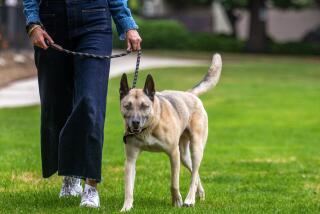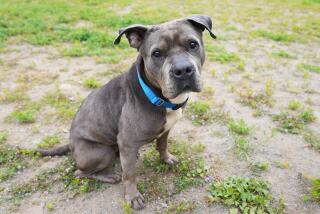Basic Advice Can Help Kids Avoid Attacks
- Share via
You can reduce the chances of children in your care being bitten or injured by a dog if you teach them some basic safety tips:
* Never approach an unfamiliar dog.
* Never run from a dog and scream.
* Stay still when an unfamiliar dog comes up to you (“be still like a tree”).
* If knocked over by a dog, roll into a ball and lie still (“be like a log”).
* Do not look a dog in the eye.
* Do not disturb a dog that is sleeping, eating or caring for puppies.
* Do not pet a dog without letting it see and sniff you first.
* Never play with a dog unless supervised by an adult.
Any adult can lessen the risk of dog bite injuries. For example:
At Home
* Never leave an infant or child alone with any dog.
* Teach your dog submissive behavior, such as rolling over to show its stomach.
* Do not play aggressive games with your dog, such as wrestling.
* Seek medical care for any serious dog bite, and report all dog attacks.
In the Community
* Support animal-control programs in your community and the enforcement of local laws regulating dangerous or vicious dogs.
* Support dog bite prevention educational programs in schools.
* Get the advice of a veterinarian about the right breed of dog if you are thinking about getting a family pet.
* Spay or neuter your dog; this often reduces its aggressive tendencies.
* Be sure all pets are properly immunized.
* Seek a veterinarian’s advice quickly if your dog becomes aggressive.
If you are approached by a dog that may attack you:
* Never scream and run. Remain motionless, hands at your sides, and avoid eye contact with the dog. Once the dog loses interest in you, slowly back away until it is out of sight.
If you are bitten or attacked by a dog, try not to panic.
* Immediately wash the wound thoroughly with soap and warm water.
* Contact your physician for additional care and advice.
* Report the bite to your local animal care and control agency.
* Tell the animal control official everything you know about the dog, including its owner’s name and address. If the dog is a stray, tell the animal control official what it looks like, where you saw it, whether you’ve seen it before and in which direction it left.
Source: Humane Society of the United States
More to Read
Sign up for Essential California
The most important California stories and recommendations in your inbox every morning.
You may occasionally receive promotional content from the Los Angeles Times.













